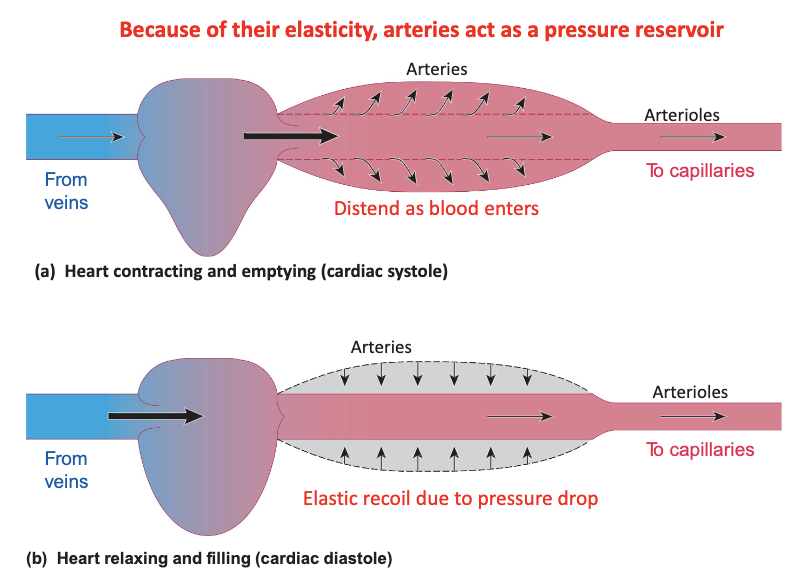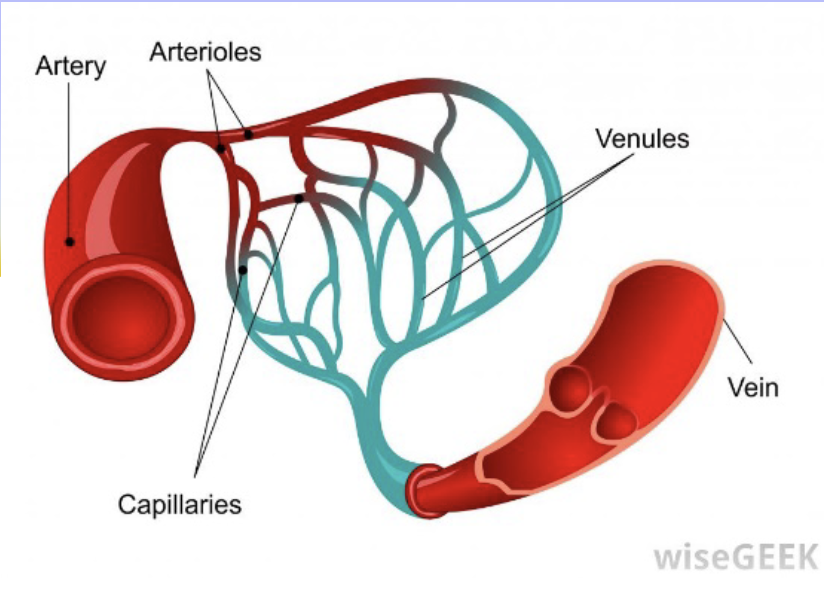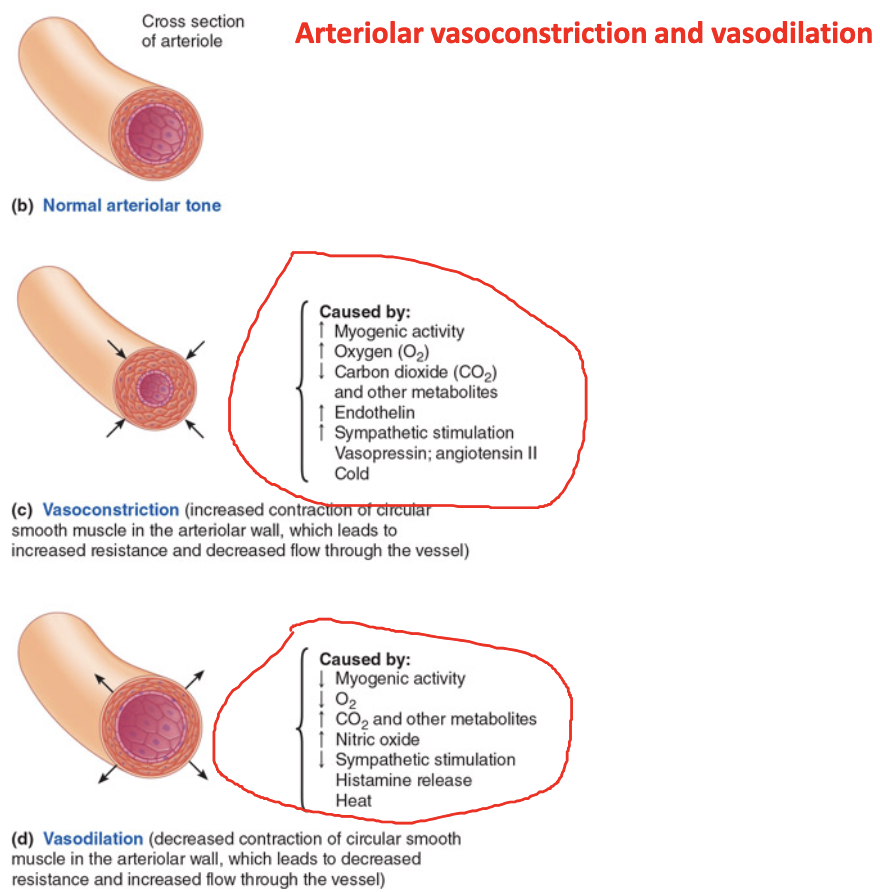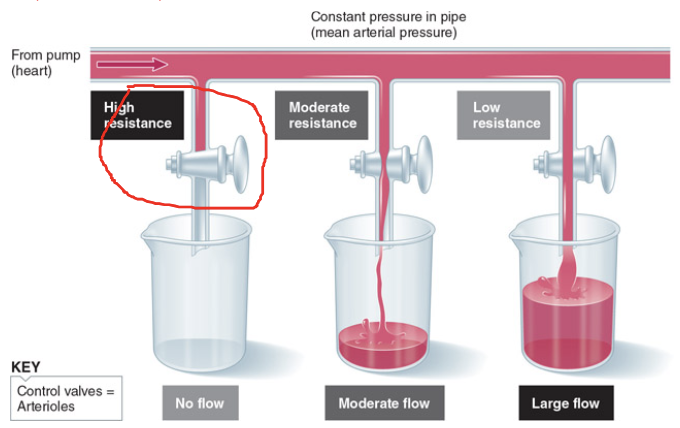Chapter 10 Blood Vessels and Blood Pressure
Patterns and Physics of Blood flow
blood
is transported to all parts of the body through the blood vessels
Brings fresh supplies to cells
removes wastes
transports chemical messengers
Blood is constantly “reconditioned”
reconditioning organs include
receives more blood to maintain homeostasis
Kidneys (eliminate wastes)
Digestive tract (to pick up nutrients)
Skin (eliminate heat)
Blood flow rate through the vessel is
proportional to pressure gradient (ΔP)
inversely proportional to the vascular resistance (R)
F (flow rate of blood through a vessel) equation
F = ΔP/R
Factors in Blood Flow
ΔP- Pressure gradient
difference in pressure between the beginning and end of a vessel
contraction of the heart imparts pressure to the blood—> drives the blood flow
Vascular resistance (R)
Opposition to blood flow through a vessel, due to friction between the fluid and the vessel wall
Rαη L/r^4
R is proportional to viscosity ηand depends on L and r
η-viscosity. Directly proportional
L-Vessel length. Directly proportional
r= vessel radius Inversely Proportional (major determinant)
Poiseuille’s Law
Flow rate = (pi*ΔP*r^4)/(8*η*L)
Vascular Tree
systemic and pulmonary circulation-each consist of a closed system of vessels
Arteries- transport blood from the heart to the organ
Arterioles-control the amount of blood that flows through each organ
Capillaries-vessels where materials are exchanged
Venules- capillaries join to form venules
Veins-venules merge to form veins that return the blood to the heart
Arteries
rapid transit passageways to organs
the heart contracts to pump blood into arteries and relaxes to refill
Arterial pressure fluctuates
Systolic pressure averages 120 mm Hg
Diastolic pressure averages 80 mm Hg
Changes in pressure will affect vessels (normal)
mean arterial pressure is driving force for blood flow
Avg pressure driving blood forward into the tissues throughout the cardiac cycle

Arterial blood pressure is the force exerted by blood against the vessel wall
depends on the blood volume and on the vessel compliance
ΔP=ΔV/C
c- compliance
measuring blood pressure
Pressure cuff (sphygmomanometer)
Cuff is inflated→applies pressure on brachial artery
If cuff pressure >systolic pressure → artery is pinched; no blood flow; no sound .
If cuff pressure falls below the systolic pressure →the artery partially opens; blood flow is turbulent; makes sound
If cuff pressure < diastolic pressure →laminar flow; no sound
Blood Pressure
MAP- mean arterial pressure
MAP = diastolic pressure + (1/3) pulse pressure
pulse pressure = systolic pressure — diastolic pressure
MAP is closer to the diastolic pressure
2/3 of the cardiac cycle is spent in diastole

Arterioles
the major resistance vessels
radius is small→considerable resistance to flow → pulsatile pressure converts to the non-fluctuating pressure entering the capillaries
the pressure drop from 93 mm Hg to 37 mm Hg
it declines in pressure encourages blood flow to the organs downstream
Vasoconstriction - narrowing of a vessel (due to smooth muscle contraction)
Vasodilation - enlargement in circumference and radius of a vessel (due to smooth muscle relaxation)
Vascular tone - state of partial constriction of arteriolar smooth muscle, establishes a baseline of arteriolar resistance
intrinsic myogenic activity of the smooth muscle

Local Control of Arteriole Radius
fraction of cardiac output (CO) delivered to an organ depends on its demand for blood at each particular time
differences in blood flow various organs are determined by
differences in vascularization
differences in resistance offered by arterioles supplying each organ
important in determining the blood flow and hence the distribution of CO to that organ

Local Influences on Arteriolar Radius